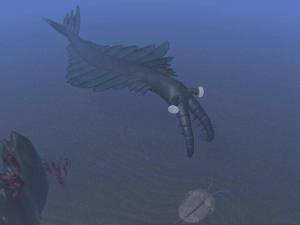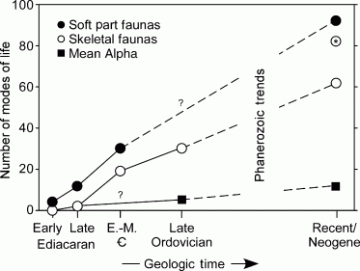Did animal phyla suddenly appear in the Cambrian Explosion?
Paleontologists have discovered that new animal forms almost always appear abruptly--not gradually--in the fossil record, without any obvious connections to the animals that came before.Explore Evolution, p. 22
About 530 million years ago, more than half of the major animal groups (called phyla) appear suddenly in the fossil record.Explore Evolution, p. 22
 Anomalacaris: a fearsome predator of the Cambrian. Image from WikiCommons
Anomalacaris: a fearsome predator of the Cambrian. Image from WikiCommons
Summary of problems with claim: The events of the Cambrian explosion are subject of ongoing debate and research. Some scientists argue that the fossils we see in the Cambrian represent the ancestors of modern phyla before those different groups had fully separated, and that the phyla truly emerged over a longer period of time. There are also questions about the preservation of fossils before the Cambrian, and it is possible that the explosion of fossils during the Cambrian represents a shift toward predator-resistant (and readily fossilized) exo-skeletons, rather than a shift in the actual diversity of life.
Full discussion: To suggest that, during the Cambrian explosion, "more than half of the major animal groups (called phyla) appear suddenly in the fossil record" (Explore Evolution, p. 22) stretches the true state of affairs. A number of fossils discovered from that period of time possess traits characteristic of modern phyla. Other species found at that time cannot be clearly classified in any modern phyla at all. Fossils from the period following the Cambrian, an era known as the Ordovician, more clearly show the distinct groups possessing the traits associated with many modern phyla. Fossil deposits before the Cambrian are rarer, making it difficult to be sure how sudden any appearances were.
 Palaeontology 50(1):1 22. "Change through time in realized ecospace. Top line represents all recorded modes of life, middle line represents modes of life of skeletal fauna only; bottom line records mean number of modes of life for single assemblages. For the Recent, the open circle represents those recent taxa with readily preserved hard parts, and the open circle containing an asterisk represents those taxa with a diverse fossil record."" title="Modes of Life as Function of Time: Figure 8 from Richard K. Bambach, Andrew M. Bush, Douglas H. Erwin (2007) "Autecology and The Filling of Ecospace: Key Metazoan Radiations" Palaeontology 50(1):1 22. "Change through time in realized ecospace. Top line represents all recorded modes of life, middle line represents modes of life of skeletal fauna only; bottom line records mean number of modes of life for single assemblages. For the Recent, the open circle represents those recent taxa with readily preserved hard parts, and the open circle containing an asterisk represents those taxa with a diverse fossil record."" class="image image-img_assist_custom" width="360" height="271" />Modes of Life as Function of Time: Figure 8 from Richard K. Bambach, Andrew M. Bush, Douglas H. Erwin (2007) "Autecology and The Filling of Ecospace: Key Metazoan Radiations" Palaeontology 50(1):1 22. "Change through time in realized ecospace. Top line represents all recorded modes of life, middle line represents modes of life of skeletal fauna only; bottom line records mean number of modes of life for single assemblages. For the Recent, the open circle represents those recent taxa with readily preserved hard parts, and the open circle containing an asterisk represents those taxa with a diverse fossil record."
Palaeontology 50(1):1 22. "Change through time in realized ecospace. Top line represents all recorded modes of life, middle line represents modes of life of skeletal fauna only; bottom line records mean number of modes of life for single assemblages. For the Recent, the open circle represents those recent taxa with readily preserved hard parts, and the open circle containing an asterisk represents those taxa with a diverse fossil record."" title="Modes of Life as Function of Time: Figure 8 from Richard K. Bambach, Andrew M. Bush, Douglas H. Erwin (2007) "Autecology and The Filling of Ecospace: Key Metazoan Radiations" Palaeontology 50(1):1 22. "Change through time in realized ecospace. Top line represents all recorded modes of life, middle line represents modes of life of skeletal fauna only; bottom line records mean number of modes of life for single assemblages. For the Recent, the open circle represents those recent taxa with readily preserved hard parts, and the open circle containing an asterisk represents those taxa with a diverse fossil record."" class="image image-img_assist_custom" width="360" height="271" />Modes of Life as Function of Time: Figure 8 from Richard K. Bambach, Andrew M. Bush, Douglas H. Erwin (2007) "Autecology and The Filling of Ecospace: Key Metazoan Radiations" Palaeontology 50(1):1 22. "Change through time in realized ecospace. Top line represents all recorded modes of life, middle line represents modes of life of skeletal fauna only; bottom line records mean number of modes of life for single assemblages. For the Recent, the open circle represents those recent taxa with readily preserved hard parts, and the open circle containing an asterisk represents those taxa with a diverse fossil record." Ecologically, the Cambrian fossils represent a smooth extension of the rate of diversification before and after. An analysis of the lifestyles of the Cambrian fossils, Ediacaran (pre-Cambrian) fossils, and fossils from eras after the Cambrian shows a steady increase in ecological complexity, not an explosion of diversity. The nature of that expansion is informative, though.
Cambrian fossils include the first predators capable of hunting and capturing prey (rather than passive filter-feeders). This behavioral development had adaptive consequences for concurrent species, and some evidence supports the contention that the Cambrian fossils seem more diverse simply because hard bodyparts evolved as protection against predators preserved better than the soft bodies that preceded the Cambrian. For these and other reasons, the record of pre-Cambrian fossils is not necessarily adequate for a full evaluation of the predecessors of Cambrian fauna.
New fossil finds, and improved understanding of the biological basis for the changing body forms we find in the Cambrian, have led to revisions of the claim that so many phyla emerged in the Cambrian explosion. Fossilized remains found in Australia appear to represent a group of pre-Cambrian chordates, representatives of the phylum to which humans belong. More detailed analysis of Cambrian fossils has also shown some species to be significant branches off of the tree which led to modern species within the same phylum (Derek E. G. Briggs and Richard A. Fortey, 2005, "Wonderful strife: systematics, stem groups, and the phylogenetic signal of the Cambrian radiation," Paleobiology 31:94-112), a finding which indicates that the origin of the phylum itself lies earlier.
Study of the Cambrian fossils has also revealed that some of the examples of divergent Cambrian phyla may have been premature. Some fossils possess features indicating that they evolved from a time before certain existing phyla emerged. Because they possess certain traits in common with existing phyla, certain authors assign them to one phylum or the other, but such assignments are debatable, and new knowledge about the relationships between the modern groups has caused some such assignments to be reevaluated. Thus, the range of time over which modern phyla are seen to emerge tends to get wider as we improve our understanding of both modern and fossilized life.
Finally, our improving understanding of developmental biology is allowing scientists to better understand why the Ediacaran, Cambrian and Ordovician saw so many new body forms enter the fossil record, and why so many features of modern living things emerged during those geologic periods. A major theme of emerging from the field of developmental biology is the discovery that the process of forming the body from a fertilized egg cell is controlled by a group of genes which regulate the way that body segments form (whether the segments of an insect's exoskeleton, or the segments visible in the muscles of a fish fillet and the human spinal column). These genes, including the Hox genes mentioned elsewhere in Explore Evolution are shared by nearly all multicellular organisms, from sea sponges to humans. Those genes appear to have duplicated, diverged and played an expanded role in structuring development during the same period when the major body forms begin appearing in the fossil record (Jordi Garcia-Fern ndez, 2005, "The genesis and evolution of homeobox gene clusters" Nature Reviews Genetics 6, 881-892). Paleontologists and developmental biologists have begun working together on the hypothesis that the diversification of these genes drove the changes in body forms during that period (see, for instance, Robert Carroll, 2000, "Towards a new evolutionary synthesis," Trends in Ecology and Evolutionary Biology 15(1):27-32, or Sean Carroll's popular treatment Endless Forms Most Beautiful, ch. 6). Once critical developmental pathways became established, it may have become harder to produce major new body forms, and that may explain why those basic forms seem to appear and stabilize relatively rapidly during that period.
Evolutionary developmental biology is an active area of research, a field of study only opened in the last 10-20 years, which has the potential to radically reshape how we think about the processes driving diversity, and the framework within which we interpret fossils from the Cambrian and from earlier eras. Students should not be taught simply that fossil forms suddenly appear, they need to be taught the developmental biology, and provided with a conceptual framework so that they can appreciate the ways that life 500 million years ago differed from life as they know it. That would provide students with a map which would guide their exploration of evolution. The approach taken by Explore Evolution simply discourages students from pursuing ideas in this cutting edge field.
Advocates of the artifact hypothesis say that the Cambrian explosion is not real; it is only the result--or an "artifact"--of having too small a sample of fossils to work with.Explore Evolution, p. 30
No paleontologists say this about the Cambrian explosion. Explore Evolution does not cite references for this claim, but any casual examination of the peer-reviewed literature about the Cambrian explosion will fail to turn up a single instance of a paleontologist claiming the Cambrian explosion was "not real."
Many paleontologists now estimate the Cambrian explosion took place over a period of 10 million years or less... If Earth's whole history were a timeline the length of an American football field, the Cambrian explosion time would take up just 4 inches of the football field's total length.Explore Evolution, p. 22
We need better math in creationist textbooks:
American football field = 100 yards
1 yard = 3 feet
football field = 300 feet
1 foot = 12 inches
football field = 3600 inches
4 inches/3600 inches = 0.0011 = 0.11%
age of the Earth = 4.54 billion years = 4,540 million years
length of Cambrian Explosion according to
Explore Evolution = ~10 million years
10 million / 4540 million = 0.0022 = 0.22%
0.11% does not equal 0.22%. Q.E.D.
